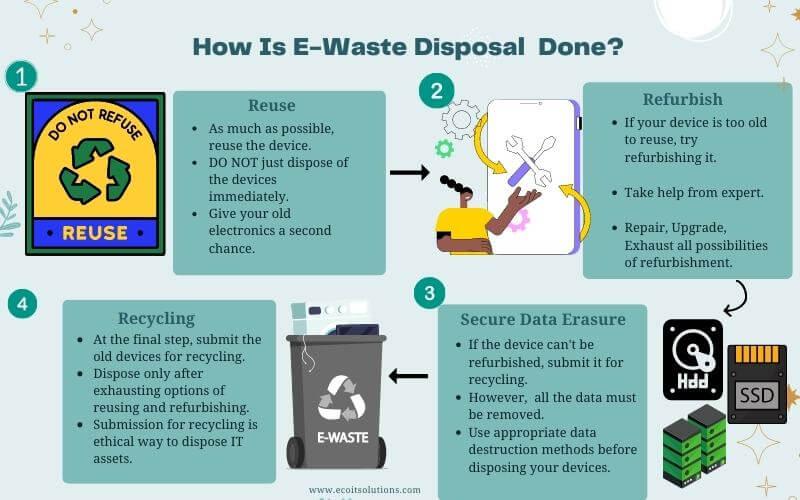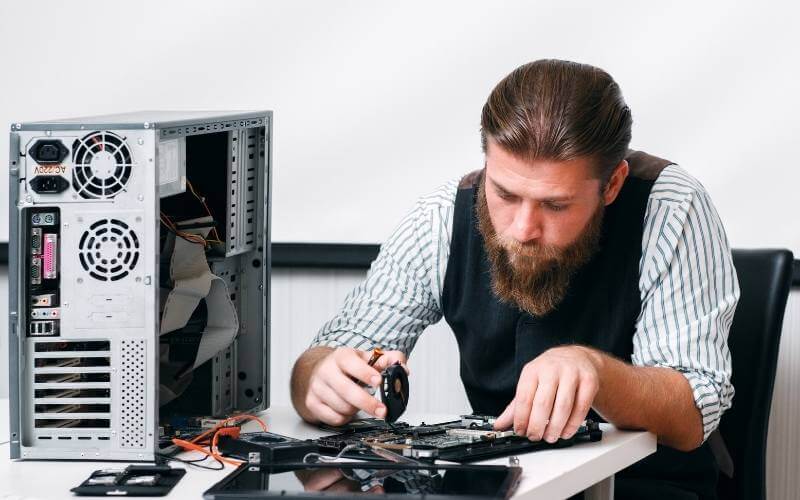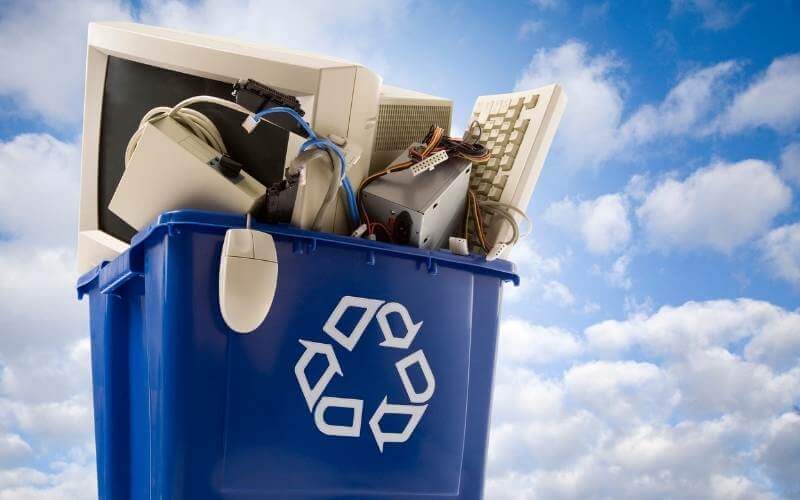As technology advances more rapidly, so does the waste it leaves behind. Therefore electronic waste disposal becomes more important than ever before. Gone are the days of large white computers; they are now replaced by slim and sleek desktop setups or easy to carry laptops.
CDs, DVDs, VHS, cassette tapes, and even the radio itself are now all obsolete – all the movies, music videos, TV shows, and songs you like can be accessed on the internet. Companies develop new products nearly every year to get consumers buying new models more often than they need to.
While these developments help make people’s lives a thousand times easier, the electronic waste produced as a result may end up causing more harm than good. But with a little discipline and creativity plus a whole lot of love for the environment, households and companies alike can learn and apply proper and sustainable e–waste disposal. In this article, learn about electronic waste and how it can best be taken care of.
What Exactly is Electronic Waste?
Electronic waste or e-waste is an umbrella term for any electrical or electronic device or equipment that is near or past its end of life. IT equipment disposal should be carried out for IT assets of businesses which is a specialized form of e-waste disposal. Examples are:
- Home appliances or white appliances such as microwaves, oven toasters, refrigerators, air conditioners, and fans
- Communication devices such as smartphones, computers, laptops, and other pieces of hardware
- Entertainment devices such as DVDs and CDs and their players, television sets, speakers, and video games
- Other electronic items such as remote controls, electrical wires, and chargers
- Office equipment such as printers, copiers, computers, IT hardware such as servers
Why Should You be Concerned with Electronic Waste Disposal?
The last thing anyone needs is for their e-waste to end up in a landfill. Electronic waste contains hazardous materials that pollute land and water and are also extremely harmful to human health. In Australia alone, millions of electronic waste get thrown out every year.
To prevent these from ending up in a landfill, the Australian government responded by putting together the National Television and Computer Recycling Scheme which provides businesses as well as residents easy access to e–waste disposal and recycling services. The problems of laptop disposal and computer disposal in Sydney and around Australia are largely eased by this government initiative. Having said that, a lot more needs to be done, and businesses can help lead the way.
E-Waste Disposal: Best Practices to Follow
When you believe it is finally time to dispose of your electronic waste, there are four steps for you to follow: reuse, refurbish, secure data erasure, and recycle. These methods can be used for secure computer disposal, secure hard disk disposal, and any other possible electronic waste that needs to be disposed of.
Reuse
If you don’t want to use it anymore, have someone else do the reusing. If your mind is set on buying new, don’t throw away those items just yet. Consider selling, donating, or giving them away. You can sell or give most e-waste items away at a portion of their original price.
You can also break it apart and sell its working parts. Most of the time, only a few damaged parts cause an equipment dysfunction, but throwing the whole thing away would mean ignoring the value of the parts that would still function.
A technique called remarketing can also take those items out of your hands. An e-waste remarketing service provider will first identify how best to advertise your equipment; if they see it still has a resale value, they will purchase it from you and resale your IT assets. The best ones offer data wipe services to ensure your sensitive information from any electronic item does not fall into the wrong hands.
Refurbish
Refurbishing simply means having your items repaired. It would be helpful to think about how you can extend the longevity of your electronic devices or appliances first. Exhaust all possible ways: avail of repairs or replace parts. After that, you can use it again or sell the newly repaired item. This will also encourage you to get more serious about electronics early at the buying stage and reduce pressure for e-waste recycling. Consider quality and length of use, especially if you’re buying in bulk.
Refurbishing refers to when specialists exhaust all ways to repair a device or piece of hardware to bring it back to its good-as-new state or recover a decent level of functionality it. They might add more memory, and hard disk space, or do some special troubleshooting if your device has unique issues. Refurbishing, therefore, extends the life span of your device.
Refurbishing becomes more beneficial when you cannot afford to buy a new device to replace your old one. Many people think that to get the best laptop for work, for example, they need to dispose of the old, poorly functioning one and buy a completely new one, with the assumption that new automatically means perfectly functioning. New devices will work great, but you would be getting more value out of your original purchase, and your existing laptop if you rather have it refurbished.
Looking at the bigger picture, using your existing device for a couple more years or so also keeps it out of a landfill for that same amount of time. If a lot of people practice the same thing, we could be reducing e-waste significantly.
Secure Data Erasure
Data Erasure is one of the most important considerations to make when disposing of data-bearing electronic waste. Erasing your data from devices could possibly not be enough to ensure security, this can be extracted (or recovered) by people with the right skill set for malicious intentions.
As an organization, there may be confidential information, proprietary data, and sensitive customer information. All information must be protected. Companies that provide secure e-waste disposal solutions need to ensure data security, and this is one of the important elements of e-waste disposal.
For an organization, it is important to secure the data from computers, servers, storage devices, and all other data-bearing IT assets. Secure destruction of the data before disposing of e-waste is very important. Organizations must know the differences between data erasure and data destruction to find appropriate services before disposing of their e-waste. Secure data destruction services should be an important consideration for businesses as well as individuals.
Recycle
When reusing is not an option anymore, just make sure your electronic waste ends up in a recycling facility and not in a landfill. There are many advantages to recycling. As mentioned above, e-waste contains hazardous materials (lead, mercury, and cadmium to name a few) that can contaminate the environment.
But aside from that, e-waste can also contain valuable materials like tin, nickel, copper, aluminum, and plastic which can be used to create other new products. This process supports a bright environmental solution called the “circular economy.” In a circular economy, nothing goes to waste: using the right tools and techniques, anything can be broken apart to create something new.
Recycling is incredibly convenient as some ITAD specialists also focus on a convenient waste collection service on top of recycling and remarketing. Just call up your e-waste recycling services provider and they will do all the heavy lifting (also literally) of e-waste recycling so you don’t have to.
Proper E-waste Management Requires Individual and Collective Responsibility
When we think of dumpsites and landfills, the first image that comes to mind is heaps of plastic bags and containers. We often forget about electronic waste, which is understandable, since these are not so easily disposed of. However, once we take a step back and see just how much electronic waste is being accumulated by the whole population over time, we begin to realize just how important it is for each person to do their part in managing electronic waste.
The simple decision to have your device refurbished, resold, or transferred (after data erasure), or submitted to a recycling facility goes a long way!
Have Eco IT Solutions Take Care of your E-waste Disposal
At Eco IT Solutions, we are committed to doing what’s right for the environment. Our services such as e-waste collection, secure data destruction, and e-waste recycling make it easy for you and your company to do the same. From secure data destruction and decommissioning to e-waste recycling, we’ve got you covered. Let us know how we can be of help. Call us at 02 8055 3775 or email us at info@ecoitsolutions.com. You may also leave us a message via our online inquiry form.
FAQs
[ecoit_faq]




Comments
One response to “E-Waste Disposal & How To Do It The Right Way?”
[…] e-waste disposal providers offer environmentally sustainable ways to dispose of electronic waste. For example, when you send your e-waste to recycling facilities, the usable metal parts of your […]